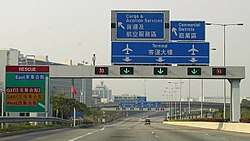Bilingual sign
A bilingual sign (or, by extension, a multilingual sign) is the representation on a panel (sign, usually a traffic sign, a safety sign, an informational sign) of texts in more than one language. The use of bilingual signs is usually reserved for situations where there is legally administered bilingualism (in bilingual regions or at national borders) or where there is a relevant tourist or commercial interest (airports, train stations, ports, border checkpoints, tourist attractions, international itineraries, international institutions, etc.). However, more informal uses of bilingual signs are often found on businesses in areas where there is a high degree of bilingualism, such as in areas where large concentrations of immigrants settle.
Bilingual signs are widely used in regions whose native languages do not use the Latin alphabet; such signs generally include transliteration of toponyms and optional translation of complementary texts (often into English). Beyond bilingualism, there is a general tendency toward the substitution of internationally standardized symbols and pictograms for text.
Bilingual signs around the world
The use of bilingual signs has experienced a remarkable expansion in recent times, especially in the western world. The increase in bilingualism there has been paralleled by increases in international travel and a greater sensitivity to the needs of ethnic and linguistic minorities.
Europe


Bilingual signs arose in places like Belgium where, because of the cohabitation of Dutch-speaking and French-speaking communities (especially in the central part of the country near Brussels), bilingualism signaled a simple willingness to accommodate all citizens equally. As a result, all street signs in the Brussels Capital Region are bilingual in Dutch and French.
Switzerland knows several cantons (Bern, Fribourg, Valais, Graubünden) and towns (e.g.: Biel/Bienne, Murten, Fribourg, Siders, Disentis/Mustér), where two, or in one case (Graubünden) even three languages have official status and therefore the signs are multilingual. With Biel/Bienne, both, the German and French name of the town are even always officially written with the compound name. The same with Disentis/Mustér (German/Romansh).
Another example is the German-speaking South Tyrol, which was annexed to Italy during World War I and eventually became the focus of assimilation policies. In observance of international treaties, Italy was eventually compelled to acknowledge and accommodate its German-speaking citizens through the use of bilingual signs. The situation of the Slovene minority living in the Trieste, Gorizia and Udine provinces is very different as only in recent years are the bilingual signs visible and only in smaller villages. In the partially French-speaking Aosta Valley, official road and direction signs are usually in both languages, Italian and French.
In Greece, virtually all signs are bilingual, with the Greek text in yellow font and the English in white. If the sign is Greek only, an equivalent sign in English will often be situated nearby.
In Spain, bilingual signs in the local language and Spanish appear irregularly in the autonomous communities of Galicia, Basque Country, Navarre, Catalonia, Valencian Community and the Balearic Islands.
Bilingual signs are also used in the Republic of Ireland, with all roads, towns, important buildings etc. named in both the Irish and English languages. The Irish appears on the top of the sign (usually in italic text) with the English underneath. The exception to this is in Gaeltacht regions, where only Irish language signage tends to be used.
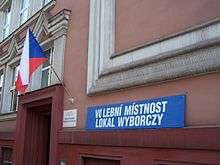
In Finland, the multilingual signs appeared at the end of the 19th century. The signs were in the official languages Swedish, Finnish and, during that period, also Russian. After the independence of Finland, the signs became bilingual Finnish - Swedish in the official bilingual areas of the country and bilingual Finnish - Sami in the northern parts.
Bilingual signs are used in the United Kingdom. In Wales, Welsh and English are official languages and most road signs are bilingual.[1] Each local authority decides which language is shown first.[2] In Scotland, Scottish Gaelic is increasingly visible on road signs, not only in the north-west and on the islands, but also on main primary routes. Railway station signs and signs on public buildings such as the Scottish Parliament are increasingly bilingual.
In parts of Slovenia, where languages other than Slovene are official (Italian in parts of Slovenian Istria and Hungarian in parts of Prekmurje), the law requires all official signs (including road signs) to be in both official languages. This regulation is not always strictly enforced, but nevertheless all road signs in these areas are bilingual.
In many regions of Poland bilingual signs are used: Polish and Ruthenian in Lemkivshchyna, Polish and German in Upper Silesia, Polish and Lithuanian in Puńsk commune and Polish and Kashubian in Pomerania.
In Turkey bilingual(Turkish and Kurdish) village signs are used in Eastern Anatolia Region[3][4][5] Airports, touristic areas include an English name after its Turkish name.
European airports have signs that are generally bilingual with the local language and English, although there are significant variations between countries. In multilingual countries such as Belgium and Switzerland, airports generally have signs in three or four languages. Some airports, such as Amsterdam Airport Schiphol, are used primarily by international travellers, and choose to use unilingual English signs, even if they are located in a non-English-speaking country.
North America
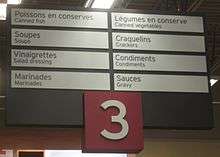

The Government of Canada and the Province of New Brunswick are officially bilingual in English and French, so all signs issued or regulated by those governments are bilingual regardless of where they are located. Provincial road signs are also bilingual in French-designated areas of Manitoba and Ontario.[6] Each local authority decides which language is shown first.[7] In Ottawa, the national capital, the municipal government is officially bilingual so all municipal traffic signs and road markers are bilingual. Since airports are regulated by the federal government, most airports in Canada have bilingual signs in English and French.
In the Province of Nova Scotia, particularly on Cape Breton island, a number of place-name signs are bilingual in English and Scottish Gaelic.
Nunavut, an Inuit territory, is officially bilingual in Inuktitut and English so territorial government-issued signs are posted in both languages. Municipal road signs have remained in English only.
Quebec is officially unilingual in French, and the use of other languages is restricted under the Charter of the French Language. Commercial signs in Quebec are permitted to include text in languages other than French as long as French is "markedly predominant".[8]
At places near the U.S.-Mexico border, some signs are bilingual in English and Spanish, and some signs near the U.S.-Canada border are bilingual in English and French. Additionally, large urban centers such as New York City, Chicago and others have bilingual and multilingual signage at major destinations. There are a few English and Russian bilingual signs in western Alaska. In Texas, some signs are required to be in English and Spanish. In Texas areas where there are large numbers of Spanish speakers, many official signs as well as unofficial signs (e.g. stores, churches, billboards) are written in Spanish, some bilingual with English, but others in Spanish only.
In 2016, Port Angeles, Washington installed bilingual signs in English and the indigenous Klallam languages to preserve and revitalize the area's Klallam culture.[9]
Asia
In the People's Republic of China, bilingual signs are mandated by the government in autonomous regions where a minority language share official status with Chinese. In Xinjiang, signs are in Uyghur and Chinese; in Tibet, signs are in Tibetan and Chinese, in Inner Mongolia, signs are in Mongolian (written in the classical alphabet) and Chinese. In Guangxi, the majority of signs are in Chinese, even though the Zhuang language is official in the region. Smaller autonomous areas also have similar policies. Signs in Yanbian Korean Autonomous Prefecture, which borders North Korea, are in Korean and Chinese. Many areas of Qinghai province mandate bilingual signs in Tibetan and Chinese. In Beijing and Shanghai, due to international exposure of the 2008 Summer Olympics and Expo 2010, almost all city traffic signs are now bilingual with Chinese and English (during the Olympics, signs on Olympic venues were also in French). English use in signs is growing in other major cities as well.
In Hong Kong and Macau, signs must be bilingual with Traditional Chinese and English or Portuguese, respectively. This is because, in addition to Chinese, English and Portuguese are official languages of Hong Kong and Macau respectively. Trilingual road signs in English, Portuguese and traditional Chinese are seen in some newly developed areas of Macau.
In Israel, road signs are often trilingual, in Hebrew, Arabic and English.
In Sri Lanka, official road signs are in Sinhala, Tamil, and English.
In Saudi Arabia and the Gulf States, road signs are often bilingual, in English and Arabic. Other signs (e.g. building signs) may also be displayed in English and Arabic.
Bilingual signs
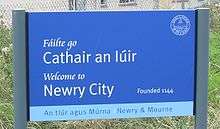
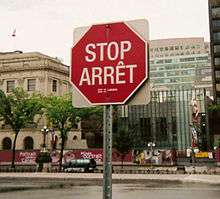
 Quadrilingual Sign at Brussels-South railway station in French, Dutch, German, and English.
Quadrilingual Sign at Brussels-South railway station in French, Dutch, German, and English.
 A bilingual sign for tourist cars in Karaköy before Galata Bridge, Turkey
A bilingual sign for tourist cars in Karaköy before Galata Bridge, Turkey A sign at Tucson Medical Center in Tucson, AZ, USA in Spanish and English.
A sign at Tucson Medical Center in Tucson, AZ, USA in Spanish and English.
See also
Bibliography
- Francescato, G. Le aree bilingui e le regioni di confine. Angeli
- Baldacci, O. Geografia e toponomastica. S.G.I.
- Baines, Phil. Dixon, Catherin. Signs. UK: Laurence King Co., 2004 (trad.ital. Segnali: grafica urbana e territoriale. Modena: Logos, 2004)
- Boudreau, A. Dubois, L. Bulot, T. Ledegen, G. Signalétiques et signalisations linguistiques et langagières des espaces de ville (configurations et enjeux sociolinguistiques). Revue de l'Université de Moncton Vol. 36 n.1. Moncton (Nouveau-Brunswick, Canada): Université de Moncton, 2005.
- Bhatia, Tej K. Ritchie, William C. Handbook of Bilingualism. Oxford: Blackwell Publishing, 2006.
References
- ↑ "Language". wales.com. Welsh Government. 2012. Archived from the original on 22 July 2012. Retrieved 17 July 2012.
- ↑ "Bilingual roadsigns". BBC Homepage, Living in Wales. BBC. 17 July 2012. Retrieved 17 July 2012.
- ↑ http://en.firatnews.com/news/news/kurdish-village-names-added-to-signs-in-kiziltepe.htm
- ↑ http://www.todayszaman.com/news-193991-kurdish-name-inscribed-on-village-sign-in-diyarbakir.html
- ↑ http://turkey.setimes.com/en_GB/articles/ses/articles/features/departments/society/2014/01/23/feature-01
- ↑ "Bilingual Signs". Ontario Ministry of Transportation. 2010. Archived from the original on 14 April 2014. Retrieved 20 September 2014.
- ↑ "Bilingual roadsigns". BBC Homepage, Living in Wales. BBC. 17 July 2012. Retrieved 17 July 2012.
- ↑ Art. 58 of the Charter of the French Language, introduced by Bill 86 in 1993.
- ↑ http://indiancountrytodaymedianetwork.com/2016/02/29/bilingual-street-signs-herald-new-era-language-revitalization-163552

